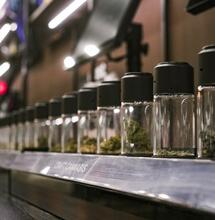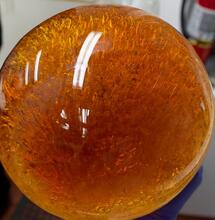A Dab Too Far?

Although weed extracts seem to be everywhere these days, their production comes with risks. Is it safe to engage in extracting at home? Extra caution is required if you do proceed with such plans. Read more on cannabis extracts, get tips from an expert, and also read a testimony from someone who has been hurt while extracting on their own.
Cannabis extracts are huge business in the legal marijuana market in the United States; the ‘pure hit' on offer from concentrated Cannabinoids provides medical (and, of course, recreational) users with an intense and long-lasting, effect. Of course, with extracts containing anywhere between seventy and ninety percent active compounds, it is easy to see why they are so popular.
Check out the online ‘menu' from any Colorado-based pot shop and you will be met with a bewildering array of oils, dabs, wax, shatter and budder, each one looking shinier and tastier than the last... I urge you to do this, as it is fascinating!
The extract market is taking America by storm and - while the origins of concentrates can undoubtedly be traced back to the jelly butane hash of the 1960s - there is no doubt that the current popularity in the United States has accelerated its current impact on European shores.
Now, for those of you who do not know, cannabinoids can be extracted from plant material in a number of ways, with the most unobtrusive being dry-sieve, using sieve screens to separate trichomes from plant material or water extraction, using ice and multiple micron-level screens (bubble bags) to separate the trichomes. While these methods achieve perfectly wonderful and potent extracts - Ice-o-lator, anyone? - to achieve a true ‘concentrate,' solvents or CO2 must be employed to strip the plant material of its desirable compounds.
CO2 extraction is the least toxic form of extraction in the sense that it has the lowest environmental impact. It involves CO2 being kept in a fluid state by holding it above its critical pressure point (hence the term ‘super-critical' extraction) and forcing it through the plant material. The CO2 acts as a solvent and strips everything out of the material to create the extract. This technique is also used to decaffeinate coffee beans.
CO2 extraction is incredibly difficult to perform without the use of expensive high-pressure equipment and, while it is commonly used in America, this method is very much out of the reach of the small-scale, domestic producer.
This brings us to the more common solvents used. Solvent extraction techniques involve running or ‘washing' a solvent through ground-up plant material; the active compounds dissolve into the solvent and are then left behind in the form of a concentrate, once the solvent has been evaporated away. The most common solvents used are butane gas and isopropyl alcohol, both of which are soluble in water. This means that, once the initial run has been performed, the extract needs to be gently heated either via a coffee plate, oven tray or vacuum oven to get rid of the trapped solvent. This is called purging.
Still with me? Good.
Now, at this point, some of you may well be thinking to yourselves that heating up flammable and explosive solvents sounds like a one-way ticket to losing your eyebrows - and you would be right. When done in a controlled, well-ventilated environment, the process is relatively safe; however, when the environment is not controlled, it is anything but safe.
Underground extraction labs are making the headlines for all the wrong reasons. In Colorado last year, explosions in homemade extraction operations hit the newspapers at a rate of around three per month, taking up almost as many column inches as reports about meth labs. Baking Bad!
The fear among European Cannabis activists is that accidents will also begin to increase in frequency on their soil. Nothing would harm the movement for legalization and normalization like a regular flow of Daily Mail-baiting explosions in residential extraction labs.
That is not to detract from the fact that someone will get seriously hurt in the process. We caught up with ‘Kev,' an experienced hand at the extraction game, and picked his brains about how to get the best extracts without blowing yourself into the neighbor's livingroom!
Soft Secrets: Hi Kev, thanks for speaking to us, mate. First of all, what kind of extracts are you producing?
Kev: Hi, Soft Secrets, good speaking with you. We currently make the hemp oil and the shatter. We have been experimenting lately and made different forms of the oils; we have made wax and also some honey oil. It's time consuming to make, and a bit trickier, but worth the hassle in the end.
SS: What extraction techniques are you using?
K: We use two different extraction methods for the different extracts that we produce. If we want to make the shatter, wax or honey, then we will us the butane extraction method. If we are making the hemp oil, then it is done using the IPA (isopropyl alcohol). The different methods give you different end results. The butane give you a much more purified form of extract, which makes it good for smoking; the IPA method also extracts a lot of the plant compounds due to how it has been stripped.
SS: Was it a steep learning curve? Did you have any accidents?
K: I spent two days over in Spain learning how to make the oils safely; otherwise, I wouldn't give it a go, as too many things can go wrong. No accidents while I was learning. I spent the first day just watching, so I didn't make any mistakes - one mistake could be your last!
SS: Please share with our readers your top five tips for extracting safely.
K: OK, here are my top five:
- If you are even slightly accident-prone, do not try this!
- No smoking or using electrical equipment (including cell phones, kettles, etc.)
- Make sure you are in a well-ventilated area with fans - outdoors is best.
- Use the correct equipment!
- Do not try to rush things by using naked flames at any point in the whole process.
Kev then introduced us to a guy who had had a nasty accident during an extraction session. Here is what he had to say:
"Hello Soft Secrets! First of all, I was using a simple method of extraction, i.e. honey bee extractor, butane gas and a Pyrex dish. The extraction took place in a friend's flat.
"I was finishing up after quite a big extraction session; many butane gas cans were used and I was about to purge the gas off. Then, my friend flicked the kettle switch and suddenly I was engulfed in a fireball and explosion! I suffered burns to both arms and face and was in a hospital burns unit for New Year's Eve and for a few days after.
"It wasn't the first time I'd done extraction and I was straight back to the extractor about a week after! I could have done it better by doing it outside, and my final words are: ventilation is key!"
So, there you have it. Do it the safe way and make sure you do not end up as a headline.
Safe extracting!
More from Soft Secrets:









